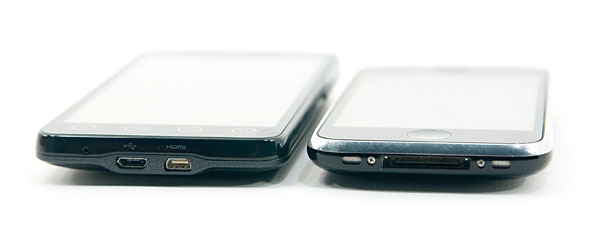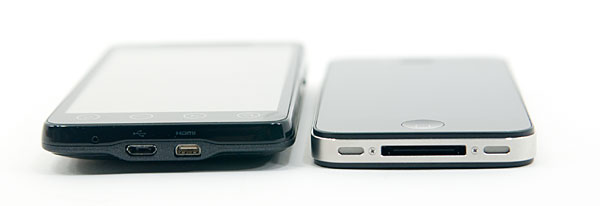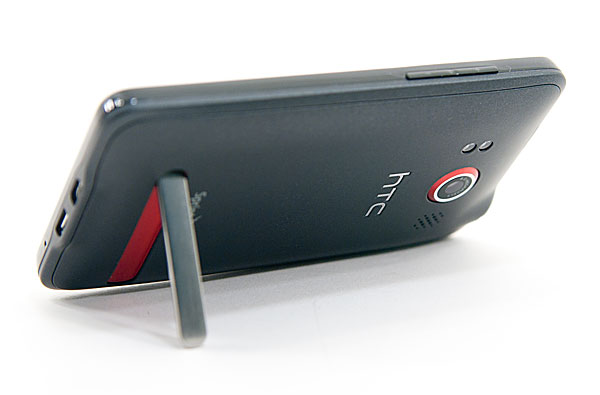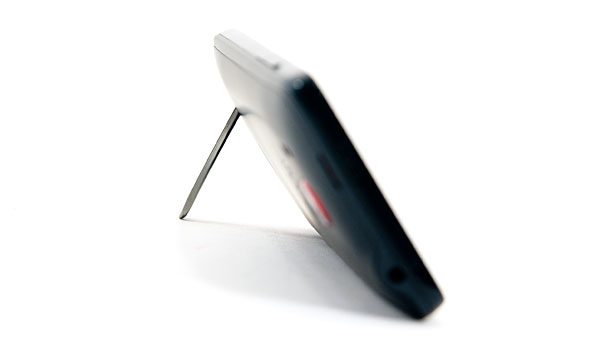The Sprint HTC EVO 4G Review
by Anand Lal Shimpi on June 28, 2010 6:04 PM ESTIt’s really not that big. It seems like it would be based on the specs and photos, but in reality the Sprint EVO 4G by HTC just isn’t that big. And it’s not levied as an insult, I just mean to say that the EVO is manageable in size.
The screen has the same 800 x 480 resolution of the Nexus One and HTC Incredible, but the pixels are spread out over a much larger 4.3” screen. The display setup to be overly red just like the other Android screens we've seen thus far, but it looks great.

The size of the screen is really what sets the EVO 4G apart from the competition, and honestly I couldn’t think of a better phone for browsing the web. Loading full websites is a pleasure and the screen is large enough where you can actually read a lot of content. It's not a tablet replacement, but it is easier to work with than a 3.5 - 3.7" screen.

From left to right: HTC EVO 4G, iPhone 3GS, Nexus One, iPhone 4
I’ve heard it referred to as a mini tablet and honestly I don’t believe that’s the case. The 4.3” screen is big but I’m telling you, it’s not that big in practice. It just ends up feeling like a phone with a good sized screen. Move into the 5” and beyond territory and then you start triggering me calling things tablets.

HTC EVO 4G (left) vs. iPhone 3GS (right)

HTC EVO 4G (left) vs. iPhone 4 (right)
The phone measures 4.8” x 2.6” x 0.5” and it’s the largest smartphone I’ve ever held. That being said, it is absolutely pocketable as long as you’re not wearing skinny jeans. Even then it is thin enough that you could slip it into your back pocket.
| Physical Comparison | |||||||
| HTC EVO 4G (Qualcomm Snapdragon QSD8650) | HTC Droid Incredible (Qualcomm Snapdragon QSD8650) | Apple iPhone 4 | Google Nexus One (Qualcomm Snapdragon QSD8250) | ||||
| Height | 121.9 mm (4.8") | 117.5 mm (4.63") | 115.2 mm (4.5") | 119 mm (4.7") | |||
| Width | 66.0 mm (2.6") | 58.5 mm (2.30") | 58.6 mm (2.31") | 59.8 mm (2.35") | |||
| Depth | 12.7 mm (0.5") | 11.9 mm (0.47") | 9.3 mm ( 0.37") | 11.5 mm (0.45") | |||
| Weight | 170 g (6.0 oz) | 130 g (4.6 oz) | 137 g (4.8 oz) | 130 g (4.6 oz) | |||
| CPU | Qualcomm Scorpion @ 1GHz | Qualcomm Scorpion @ 1GHz | Apple A4 @ ~800MHz | Qualcomm Scorpion @ 1GHz | |||
| GPU | Adreno 200 | Adreno 200 | PowerVR SGX 535 | Adreno 200 | |||
| RAM | 512MB LPDDR1 | 512MB LPDDR1 | 512MB LPDDR1 (?) | 512MB LPDDR1 | |||
| NAND | 8GB micro SD | 8GB micro SD | 16GB or 32GB integrated | micro SD | |||
| Camera | 8MP with dual LED Flash + Front Facing Camera | 8MP with LED Flash | 5MP with LED Flash + Front Facing Camera | 5MP with LED Flash | |||
| Screen | 4.3" 480 x 800 | 3.7" 480 x 800 AMOLED | 3.5" 640 x 960 LED backlit LCD | 3.7" 480 x 800 AMOLED | |||
| Battery | Removable 5.5Whr | Removable 4.81 Whr | Integrated 5.254 Whr | Removable 5.18 Whr | |||
HTC ditched the silly scroll ball of the Nexus One and the optical sensor of the Incredible and just left the EVO 4G with a row of touch sensitive buttons along the base of the screen. Home, Menu, Back and Search are all you get.
If you need a navigational aid the screen is big enough where HTC was able to include directional arrows on the on-screen keyboard. They are awkward to use at first because you’re not used to them, but afterwards they just make sense. I hardly used the scroll ball/optical trackball of the other Android phones so HTC’s decision to reclaim that real estate makes total sense to me. The screen is used for scrolling, if you need fine tuned movement just rely on the virtual arrow keys. Fine by me.
The touch screen supports haptics, which can be fully disabled. When enabled certain button presses will cause the EVO’s motor to vibrate a bit to confirm the touch. It’s a concession for those who still want some tactile feedback.

The EVO 4G is the first Android phone I’ve used with something interesting on its back: a kickstand. The metal stand lets you prop a horizontally oriented EVO on your desk at around a 45 degree angle. It’s great for watching videos, using as a clock or an alternative to a costly dock.

The stand is actually a nice touch, unfortunately the Android UI doesn’t rotate to landscape mode so it’s only useful within apps that support rotation.
Also on the back is the 8MP camera lens (there’s a 1.3MP camera on the front), two LED lights used as a flash and a speaker for the speakerphone. Along the bottom is a standard USB micro B connector and a micro HDMI (D-connector) video out. The HDMI out can only be used to output movies, it won’t mirror your display.

As its name bluntly states, the EVO 4G works on Sprint’s 4G WiMAX network. Sprint’s 4G service is currently only available in 43 cities spread over 15 states, if you find yourself in one of those states then the EVO has more than its large screen to tempt you.
The phone currently sells subsidized for $199 from Sprint after a $100 mail in rebate. Service starts at $69.99 for 450 minutes and unlimited messaging/data and goes all the way up to $134.99 per month including tethering.
| Cost of Ownership Comparison | |||||
| AT&T iPhone 4 | Sprint EVO 4G | Verizon HTC Droid Incredible | |||
| Cost of Device | $199 w/ 2 year contract | $199 w/ 2 year contract after $100 MIR | $199 w/ 2 year contract | ||
| Plan with 900 Minutes, Unlimited SMS/Data | $104.99/mo, unlimited SMS, 2GB data | $99.99/mo, unlimited SMS, unlimited data, 4G | $109.98/mo, unlimited SMS, unlimited data | ||
| Tethering | + $20/mo | + $29.99/mo | + $25/mo* | ||
| Total Monthly + Tethering | $124.99/mo | $129.98/mo | $134.98/mo | ||
| Total Cost of Ownership over 2 Years | $2718.76 | $2598.76 after $100 MIR | $2838.52 | ||
| Total Cost of Ownership over 2 Years w/ Tethering | $3198.76 | $3318.52 after $100 MIR | $3438.52 | ||
Without the mobile hotspot service, the EVO 4G is the most affordable smartphone out of the three majors over the course of two years. AT&T actually offers a better deal with tethering but you need to keep an eye on your usage; go over 2GB per month and you'll incur additional charges, which isn't tough to do if you tether a lot.










97 Comments
View All Comments
thesafetyisoff - Thursday, July 1, 2010 - link
This article needs to be re-written after the system fix for the Evo that occurred yesterday. The over-the-air system update released on June 30, 2010 fixes the battery life issue. Really.After buying my Evo, I initially had the same problem with battery life: Even using task killer aps, the phone would drain at least 15-20% of battery power EVERY HOUR. I'd plug it in overnight and it was half dead by the time I got to my office, completely dead by lunch time. I had to get an extra charging cable for the car and the office, and it would still run out of juice if I had to be in a meeting for an extended time. And forget about airline trips entirely. To make matters worse, my phone started hanging up and spontaneously rebooting, so I couldn't even use it when it had battery life. I was about to return it when I heard that a system upgrade was pending.
The update fixed EVERYTHING. No hang-ups, no reboots, and a full charge went over 14 hours with moderate use. I don't know why htc initially shipped the phones without this fix, but the problem is now gone.
Long live the Evo - on a single charge!
worldbfree4me - Thursday, July 1, 2010 - link
Great to see a non-biased and impartial article! However, I do wonder that if this review would have been done post Sprint update, would the results have been slightly better with regards to the battery test. Battery life for me personally has not been a problem for me due to me having a charger at the Office, in the Car, at Home and a Battery pack that is used when traveling that can power 2 USB devices. Also, it is a well known fact that the Stock Android UI weighs less than the HTC Sense UI. This could be why the N1 is consistently faster then the Incredible and the EVO. I suspect FROZEN YOGURT aka 2.2 should close this gap somewhat. Overall, I feel that each of the aforementioned phones is very close in terms of overall performance.rf40928 - Friday, July 2, 2010 - link
Maybe the review for the iPhone 4 wasn't complete yet..but its funny how the Iphone 4 review that Anand did proves
Iphone 4 on a "slower" 3g network is consistantly faster then the Droid on a 4G network when it comes to the web .. I guess 4G's Peak performance is theoretically better.. but are Sprints 4G average 4g Speed numbers better then ATT's avg 3g speeds??
it would seem not..
topgun966 - Saturday, July 3, 2010 - link
I noticed you said that there is a 5gb cap on 3g. That's incorrect with the Evo. Evo plan has a $10 premium which nulls that cap. The Evo is true unlimited both 3g and 4g. Great review otherwise.OzzieGT - Friday, July 9, 2010 - link
Thanks for the honest and detailed review. It's because of this review I feel better about waiting for the Samsung Epic. A little smaller, also a good screen and the Swype keyboard are making for a very interesting package...VIDYA - Monday, July 12, 2010 - link
Samsung and nokia will remain in the future with the mature platforms and technology while the USA based companies will be eager to run and fall down before learning to walk or simply take stride....... 4G by HTC and SPRINT is a joke or a watered down format war.Announcer - Saturday, October 9, 2010 - link
My business partner and I travel between Dallas/Fort Worth and the SF bay area. I have the Sprint HTC Evo and he had the At&t Iphone 4g, The Evo 4G blows away the Iphone in the Dallas metroplex area and holds its own in the SF bay area. When I am in the Dallas tethered to my Evo with my laptop I get 6 Mbps and just surfing with the Evo everything loads faster than the Iphone on At&t. Sprint 4G rules! I did have At&t a few years ago and the customer service was horrific. I got a sprint air card and was grandfathered in on the unlimited usage. I did have a At&T HTC Tilt phone and tethered it to my laptop. The speeds on At&t were abysmal then I got the sprint aircard and went from 400kbps with At&t to 1700 kbps with sprint. Needless to say my partner paid off his At&t contract, sold his Iphone and now has a Sprint Evo 4G.